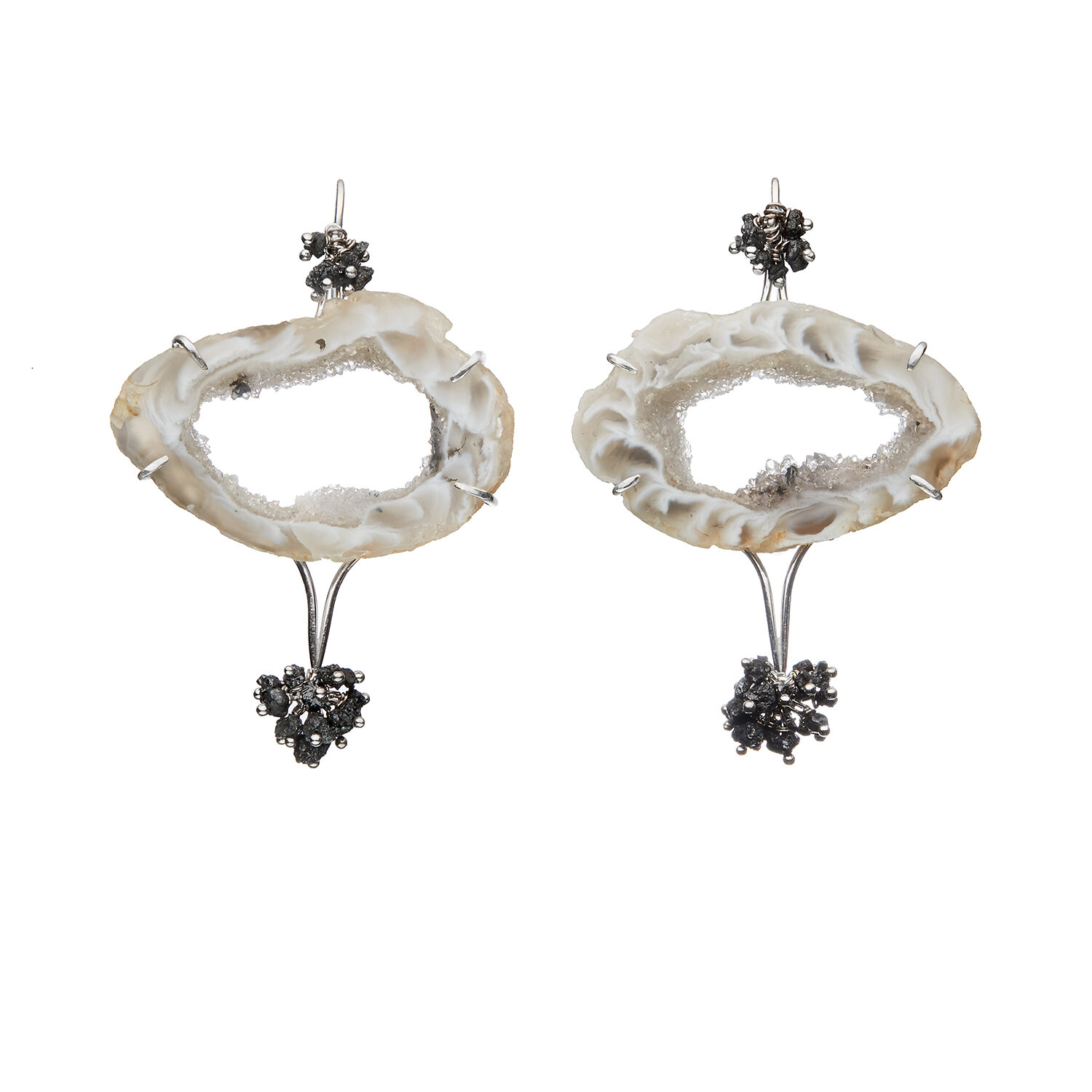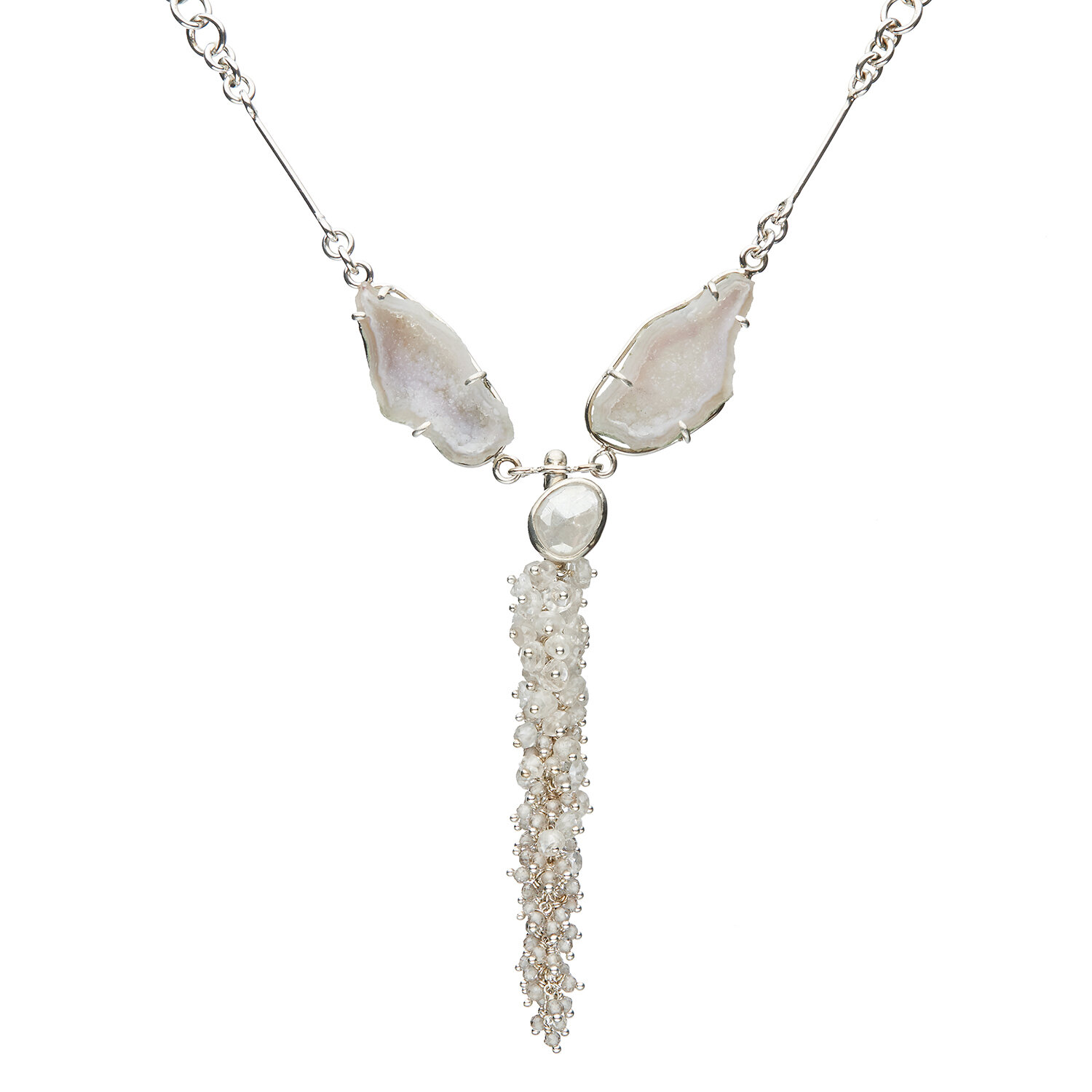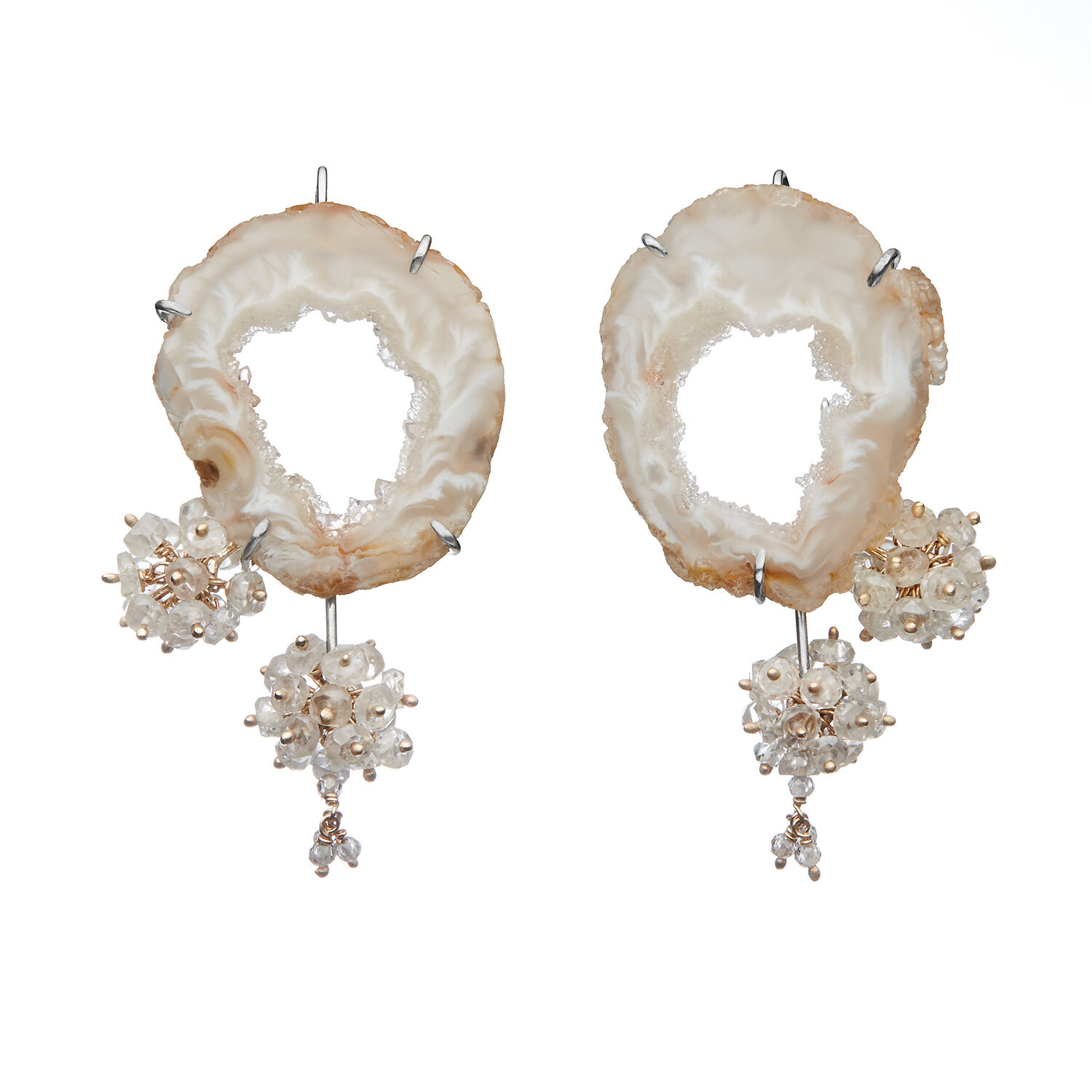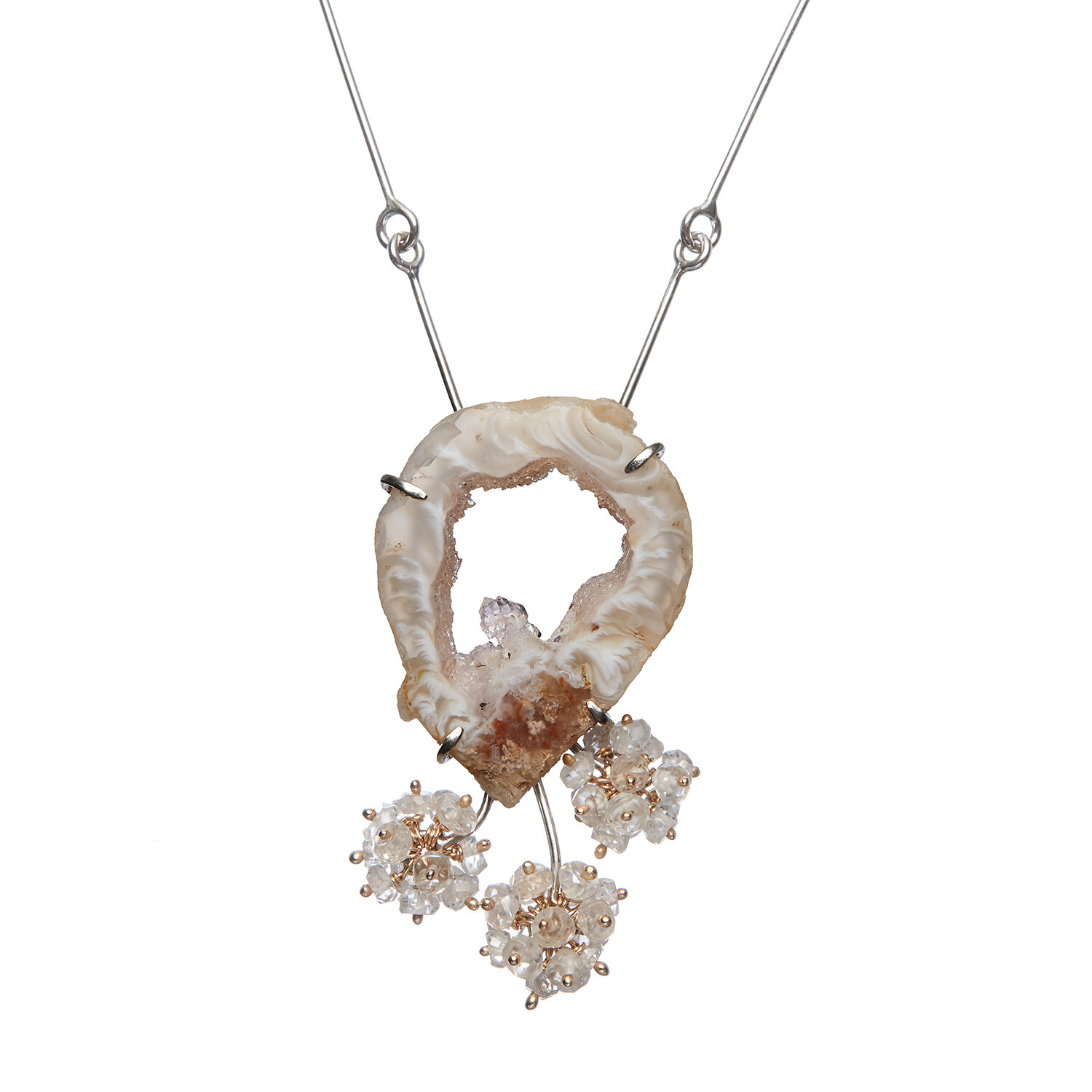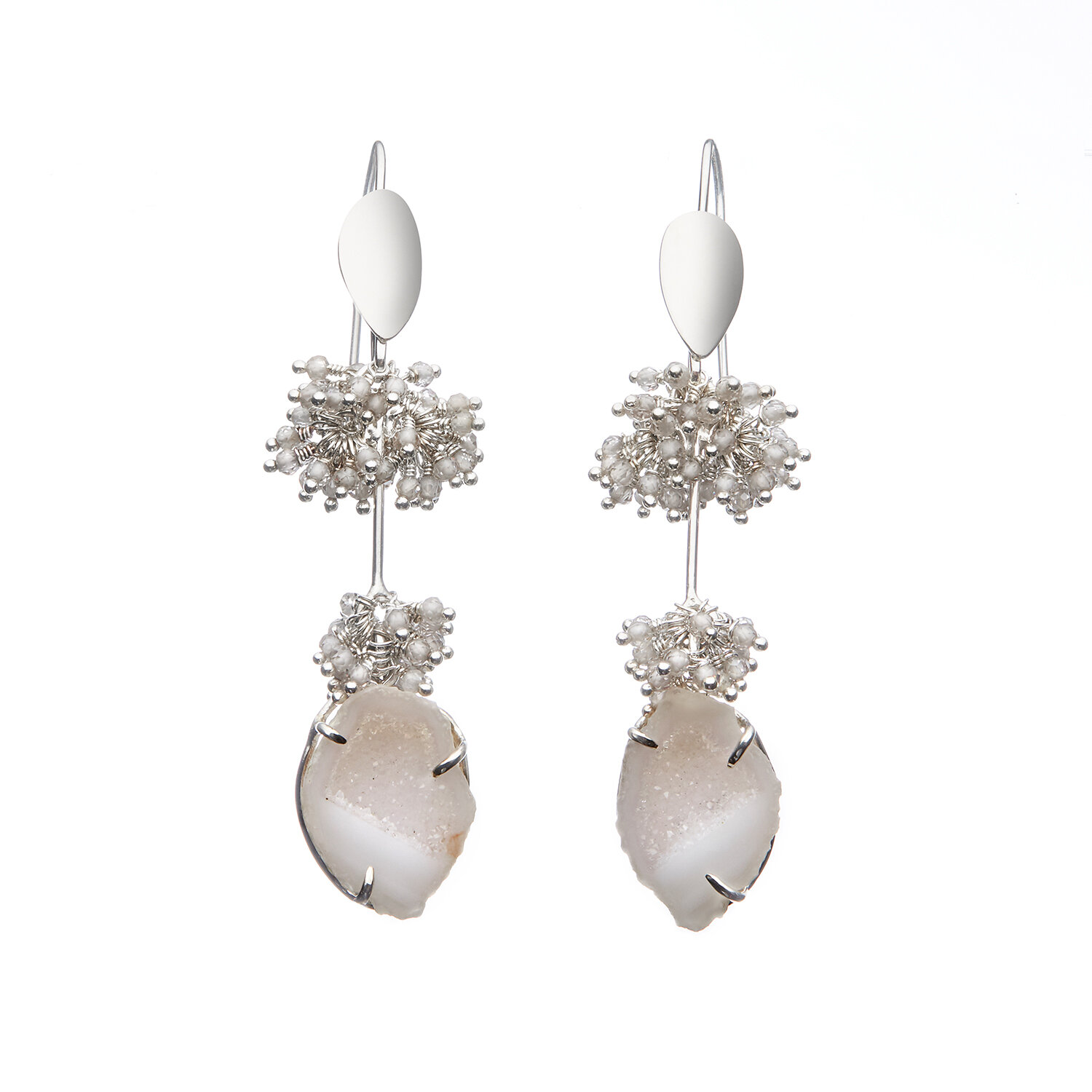Sylphide: Jewels Inspired by Starlight on Snow
Michelle Pajak-Reynolds’s one-of-a-kind ‘Zephire” earrings and pendant necklace from her “Sylphide” collection featuring 3.25 carats (total weight) pin-set raw diamond clusters and Brazilian Oco geode slices prong set in handcrafted recycled sterling silver open-back frames.
Inspired by the legend of prima ballerina, Marie Taglioni, dancing under the stars on a winter’s night, the Sylphide collection is rich in mysterious geodes, shimmering sillimanite and clusters of twinkling raw diamonds and champagne zircons. Graceful and elegant, these designs celebrate and re-imagine that magical moment as contemporary one-of-a-kind wearable works of art.
Spark of Inspiration or Blame it on Pinterest…
Ballerina Marie Taglioni first captivated my attention while I was deep in the midst of creating my Voyageuse collection in early 2018. Inspiration doesn’t wait for you to finish one project before enticing you with other wonderful ideas……. Voyageuse is inspired by the beauty of moss and while researching botanical images on Pinterest I stumbled across a photo of a necklace titled, “Necklace for Marie Taglioni” by one of my jewelry heroes, the late British artist Wendy Ramshaw.[1] Why the Pinterest algorithm dropped this artwork into my feed while I was researching a completely different subject is something I’ll never know, but knowing Ramshaw’s famous “Picasso’s Ladies” series of designs where she created one-of-a-kind jewels for women who had portraits done by Pablo Picasso, I immediately wanted to know more about Marie Taglioni.
A very, very brief biography
Marie Taglioni (1804 Stockholm, Sweden-1884 Marseille, France) was the first female ballerina to dance en pointe. Her revolutionary dance style set new standards for grace and virtuosity and ushered in a new era for ballet, what is now regarded as the Romantic Period. Despite having a severe spinal curvature, Marie followed in the footsteps of her parents, Swedish ballet dancer Sophie Karsten and Italian choreographer Filippo Taglioni. Marie often danced and trained with her younger brother Paul and prior to her Paris début at the Paris Opera at age 23 in Le Sicilen, ballet and pointe work in particular was dominated by men. Dancing on the tips of one’s toes was regarded as a masculine acrobatic form of dance, not the graceful and lyrical artform, that thanks to the Taglionis, we know today.
The public’s response to this new style was sensational. In 1832, five years after her Paris Opera début, Filippo’s ballet La Sylphide, created specifically for Marie, premiered with her in the role of the sylph, or fairy. Her costume included a formfitting bodice, bell-shaped skirt that reached mid-calf, pink tights, and tiny gossamer wings at her low back. Marie’s shortened skirts showing off her ankles and expert footwork was scandalous attire for women in the 1800s! Marie’s soft rounded arms and forward upper-body tilt not only helped hide her spinal curvature but also made her appear weightless while dancing en pointe. This costume and choreography style became the iconic look of Romantic ballet.[2] 1832 was also a big year for Marie in her personal life. She married Comte Auguste Gilbert de Voisins in July of that year. Unlike other women and especially ballerinas of her era, Marie did not give up her dance career when she got married or had her children.[3]
Marie Taglioni dancing the title role in La Sylphide. Her costume, including a formfitting bodice, shortened skirts, and gossamer wings is the iconic look of Romantic Period ballets. Artist unknown, Image credit Wikipedia
When one of Marie’s rivals, popular Viennese dancer Fanny Elssler, joined the Paris Opera, the Taglioni’s signed with the Russian Imperial Theatre so Marie wouldn’t have to share the spotlight. While traveling through Russia in the winter of 1835, Marie danced under the stars on top of an animal skin spread out over a snow-covered road to save her carriage and jewels from being robbed by a highwayman. According to various accounts, Marie then always kept a piece of fake ice in her jewelry box as a reminder of her time dancing under the stars.[4]
Upon learning this, my first thought as a jewelry artist was, “What else is in her jewelry box?,” and so began the treasure hunt for gems that sparkle like starlight on snow…..
Creating the Sylphide Collection
Faceted diamonds were too predictable and cliché for representing starlight on snow. Pearls were another obvious choice, but after working with them for years I was ready for the challenge of something entirely new to my palette of gemstones.
Shortly after finishing my Voyageuse collection in the early summer of 2018, I devoted all of my energy to my gemstone search for Sylphide. I found exactly what I was seeking while attending the American Gem Trade Association (AGTA) Show during the annual Jewelry/Gem Week in Las Vegas. “You’ll know it when you see it,” is true in so many situations and this was certainly the case when after hours of walking miles of trade show floors visiting booth after booth I found the perfect petite geode pairs in shades of pink and silvery white. These glistening barely half inch long freeform pods have the exact “starlight on snow” sparkle I was searching for and they became the key to unlocking the gate and revealing the path that the Sylphide collection was to follow.
Detail view of half of a petite Tabasco geode pair used in jewelry artist Michelle Pajak-Reynolds’s Sylphide Collection. Photo credit: Michelle Pajak-Reynolds
Phrases including “dancing watercolors, graceful and lyrical, and spirit of the dancer/artist” were part of my mood board for this collection from the beginning and rose-cut silky white sillimanite cabochons and glistening geode slices with swirling patterns in pale pink and deep champagne golds fit the aesthetic perfectly. Additional “starlight” sparkle was added with faceted light champagne zircon beads. Brightly finished recycled sterling silver and the soft yellow of 14 karat gold provide the structure upon which Sylphide is built.
Back in the studio the challenge was how to the combine all of these elements so they appear as weightless and effortless as Taglioni, and the ballerinas of her era, appeared on stage. As with all of my collections, hundreds of designs were sketched and dozens were tested before making the final edit to finished pieces. Hand-fabricating open-back prong and bezel settings was the best design solution to showcase the translucency and uniqueness of these one-of-a-kind gems and to keep the jewels light and comfortable to wear. This traditional metalsmithing and stone setting technique requires several hours per setting to complete as each element is precisely custom-built to follow the unique characteristics of each gem and securely hold it in place.
As with all of my collections, each design within Sylphide is given a name instead of a style number. To honor Marie Taglioni and the ballerinas that have followed, these one-of-a-kind designs derive their names from Romantic era ballets including some of the roles Marie danced in (Flora and Helena) and her only choreographic work, La Papillon.
If you’ve enjoyed this article you may also like:
Hill, Lorna, La Sylphide: The Life of Marie Taglioni, 1967, Evan Brothers publishers
[1] Wendy Ramshaw’s “Necklace for Marie Taglioni” was inspired by the 1940 artwork “Taglioni’s Jewel Casket” by New York artist Joseph Cornell which honored the legend about Marie Taglioni’s travels through Russia on a snowy winter night of 1835. Source: Jewelry that’s More Than Wearable Art, Felicia Craddock, New York Times, December 6, 2012
[2] The public craze for Marie Taglioni in La Sylphide launched the era of the “cult of the ballerina”. Women copied her hair, and La Sylphide dolls, cakes and other products were highly sought after by children and adults. Rumor has it that the queen of England had a La Sylphide doll. Source: Author unknown, Dancer on Wings: Marie Taglioni, LifeInItaly.com January 12, 2017
[3] Sadly, Marie’s marriage was not a happy one and she and her husband separated in 1836. Shortly after separating from Gilbert de Voisins, biographers report that Marie had a relationship with long-time fan Eugene Desmares after he defended her honor in a duel. Their relationship reportedly resulted in the birth of Marie’s first child, Eugenie Marie Edwidge in 1836. Marie had her second child, Georges Phillipe in 1842 and various historians dispute the paternity even though Gilbert de Voisins is listed on the birth certificate. Source: Murray, Christopher John (2013). Encyclopedia of the Romantic Era, 1760–1850. Routledge. p. 1122
[4] Source: Author unknown, Dancer on Wings: Marie Taglioni, LifeInItaly.com January 12, 2017





